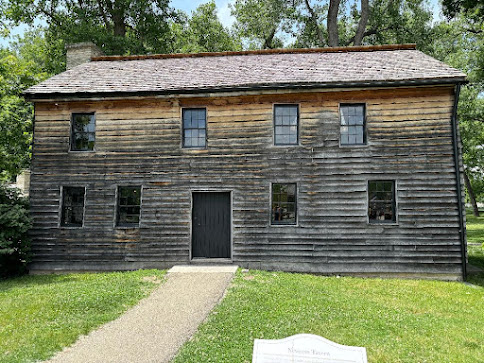We made a stop in Dayton, Ohio to learn more about the Wright Brothers after our visit to Kitty Hawk last summer as we knew the Wright Brothers had spent most of their lives in Dayton.
Dayton was founded in 1796 by 12 settlers known as the Thompson Party. In 1797, Daniel Cooper laid out Mad River Road, the first overland connection between Cincinnati and Dayton, opening the "Mad River Country" to settlement. Ohio was admitted into the Union in 1803 and the village of Dayton was incorporated in 1805 and chartered as a city in 1841. The city was named after Johnathan Dayton, a captain in the Revolutionary War who signed the U.S. Constitution and owned a significant amount of land in the area.
Dayton has been home for many patents and inventions since the 1870s and by 1890 had been granted more patents per capita than any other U.S. city. Besides the Wright brothers, Charles Kettering, world-renowned for his numerous inventions, hailed from Dayton. The city was also home to James Ritty's Incorruptible Cashier, the first mechanical cash register, and Arthur Morgan's hydraulic pump, a flood prevention mechanism that helped pioneer hydraulic engineering. Several other "items" were invented in Dayton - the auto electronic ignition (replacing the original cranking method), the pull-top can, magnetic strip on credit cards, back-pack parachute, freon coolant, and many other items. By the early 1900s, the Dayton area was known as the invention capital of the United States.
Our first stop was Carillon Historical Park, a 65 acre open-air history museum which contains historic buildings and exhibits concerning the history of technology and the history of Dayton and its residents from 1796 to the present. The historical elements of the park were the brainchild of Colonel Edward Deeds, an American engineer, inventor, and industrialist. Deeds was the president of NCR and together with Charles Kettering, founded Dayton Engineering Laboratories Company (DELCO) and was an early inventor in automotive technology. The major sections include settlement, transportation, invention and industry.
Carillon Bells
Colonel Edward Deeds
The highlight, at least for us, was the Wright Brothers National Museum.
The museum is housed in the Wright Cycle Company. The building is a replica of the shop in which Wilbur and Orville Wright designed and built their first three airplanes. The original building was located at 1127 West Third Street in Dayton. The Wrights moved their printing and bicycle business into the original building in 1897. They closed the bicycle shop in 1908, but continued to use the space as a laboratory and office until 1916. In 1935, Henry Ford bought the building and moved it to Greenfield Village in Dearborn, Michigan.
Of course, there was a lot of information and displays about bicycles.
Van Cleve Bicycle, c. 1901
We then entered Wright Hall which was designed to house the original 1905 Wright Flyer III, the world's first practical airplane. Orville Wright assisted in the planning of Wright Hall and wanted to show the plane below ground level so that visitors could see the airplane from above to understand how the controls operated. The airplane was restored from 1948 to 1950 with the initial consultation of Orville Wright before his 1948 death. The Wright Flyer III is the first airplane designated as a National Historical Landmark.
Wingspan: 40 feet, 6 inches
Length (front to rear): 28 feet
Total Weight: 710 pounds
Horsepower: 16 to 25
Propeller revolutions per minute: 490
We walked around the grounds and saw Newcom Tavern. George Newcom and his family were among the first settlers to arrive in Dayton in April, 1796.
This is the oldest standing building in Dayton. The right side of the building was the family's home, the left side of the building was the tavern. For about 65 cents a night, a traveler could have a meal and lodging for himself and his horse. Central to community life, the tavern also served as Dayton's first church, jail, general store, and Montgomery County's first court house.
Newcom Tavern
And then back into the Visitor Center to see other displays.
National Manufacturing Company began in Dayton and was established to manufacture and sell the first mechanical cash register invented in 1879 by James Ritty. In 1884, the company and patents were bought by John Henry Patterson and his brother, Frank, and the firm was renamed National Cash Register Company. Patterson formed NCR into one of the first modern American companies by introducing new, aggressive sales methods and business techniques. He established the first sales training school in 1893 and introduced a comprehensive social welfare program for his factory workers.
There were some beautiful antique cash registers on display.
Cash Register, Ritty Dial Patent Model, c. 1879
On March 23, 1913 (Easter Sunday) rain began pouring down on the Miami Valley. By the next day, the area was underwater and by Tuesday morning the streets of Dayton flooded with torrential rain. By Thursday, Dayton was under up to 20 feet of water. Over 350 people died in the disaster, with 92 losing their lives in Dayton alone.
This whistle from the NCR factory started blowing at 6 a.m. to alert the citizens of Dayton that a floor was coming.
This original 1912 Cadillac Touring car is an example of the first production vehicle built featuring DELCO's electric ignition, starting and lighting system. The car was built in Detroit with an original price of $1,800.
This extensive collection of locally made toys represents more than four decades of manufacturing during a time in which Dayton was the toy capital of America. The first patent for a wheeled friction toy was issued in 1847 to Daytonians Donald and Edith Boyer, and thus an industry was created.
Before leaving we saw an old photo of the home, Hawthorn Hill, built for Orville and Wilbur Wright and some family members. More on that in the next post.
Hawthorn Hill


















No comments:
Post a Comment